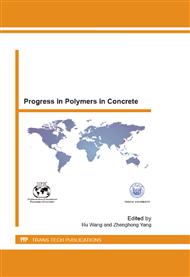p.204
p.213
p.219
p.229
p.235
p.241
p.249
p.255
p.262
Strength of Porous Polymer Concrete and Growth Properties of Plant within Planting Polymer Block Using Unsaturated Polyester Resin
Abstract:
This research was performed to provide strength property of porous polymer concrete using unsaturated polyester resin depending on the amount of binder and planting properties on coverage ratio and growth of plants in planting polymer block through planting of cool-season grass and herbaceous plant in porous polymer block. The compressive strength of porous polymer concrete depending on the binder contents and aggregate sizes were in the range of 17.1 to 23.2MPa. In the planting polymer block with Tall fescue, Perennial ryegrass and Alfalfa, the coverage ratio (in 12 weeks after seeing) were more than 7 point regardless of the kinds of plants, respectively. The roots length of plants in planting polymer block completely passed through not only the block with height of 5 cm but also the block with height of 10 cm in 20 weeks after seeding. Planting polymer block with Tall fescue, Perennial ryegrass and Alfalfa indicates that it will be advantageous to environment-friendly greening works such as greening of slopes and revetments
Info:
Periodical:
Pages:
235-240
Citation:
Online since:
April 2013
Authors:
Price:
Сopyright:
© 2013 Trans Tech Publications Ltd. All Rights Reserved
Share:
Citation:


